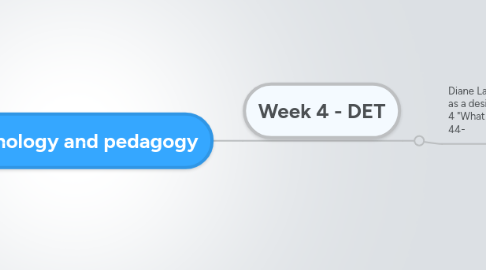
1. Week 4 - DET
1.1. Diane Laurillard - Teaching as a design science. Chapter 4 "What it takes to learn". pp 44-
1.1.1. There are two approaches to explain what happens in learning
1.1.1.1. Psychology (focuses on learning from adaptation to an environment)
1.1.1.2. Education (Focuses on the design of an environment to help others learn)
1.1.1.3. They are not mutually exclusive, but it's hard to use psychological theories in a classroom.
1.1.1.4. It is possible to see the different "isms" of psychological theory as a succession and as one building atop the previous.
1.1.2. 1. Behaviorism.
1.1.2.1. "Behavior can be manipulated through "operant conditioning", without needing to understand how the mechanism of learning takes place".
1.1.2.2. Even though we use grades and credits in a behavioristic way, this theory does not help us to make students life-long independent learners, responsible for their own process.
1.1.3. 2. Associative learning.
1.1.3.1. Pavlov and Thorndike
1.1.3.1.1. The brain associates an stimulus with the expected outcome. This leads to a conditioned response.
1.1.3.1.2. They use behaviorism, but give further insights on how the actual learning takes place.
1.1.3.2. Still today, trial and error learning processes are widely used on early childhood pedagogics for basic reading and arithmetic skills.
1.1.3.2.1. It can also help people with natural cognitive disabilities.
1.1.4. 3. Cognitive leaning.
1.1.4.1. Gestalt psychologists criticize behaviorism. They argue that learning is structurally reorganized in the learner's mind. Modern neurologic studies have proven this right.
1.1.4.1.1. They stress the importance of "meaningfulness to the learner. This was not an unconscious neural mechanism, but a conscious process that enabled the learner to make sense between the goal, the action and its result." 47
1.1.5. 4. Experiential learning.
1.1.5.1. John Dewey suggests that it's the learner's own experience what allows him to organize the situation problem and create new knowledge.
1.1.5.1.1. "The task for the teacher is to plot the appropriate sequence of realistic experiential problems for their learners." 48
1.1.5.2. Imitation patterns offer an independent alternative for learning simple tasks.
1.1.5.2.1. More complex activities need a teacher to deconstruct it and make others aware of its complexity to be able to master it.
1.1.6. 5. Social constructivism
1.1.6.1. Learning happens automatically for evolved skills
1.1.6.1.1. Other skills or knowledge discovered by other individuals require
1.1.6.2. Dewey and Vygotsky
1.1.6.2.1. Emphasize the role of language and social interaction in the learning process
1.1.7. 6. Conceptual Learning
1.1.7.1. In formal education "The facts and ideas in question are not those built up from the goals and actions of the learner, but those built up by scholars and experts over many years of careful study". p50
1.1.7.2. The main issue: how to use the teacher's communication to pass knowledge?
1.1.7.2.1. Discerning structure
1.1.7.2.2. Conceptions and misconceptions
1.1.7.2.3. Interpreting forms of representation
1.1.8. 7. Constructionism
1.1.8.1. From Dewey onward, all theorists agree on
1.1.8.1.1. Learning through experience
1.1.8.1.2. Learning through practice
1.1.8.1.3. Learning by doing
1.1.8.1.4. Learning by constructing
1.1.8.1.5. Situated learning
1.1.8.2. Constructing
1.1.8.2.1. An action or an "overt production" addressed to conceptual goal eases the process.
1.1.8.2.2. The teacher uses what students have already learned independently from their personal experience in the world.
1.1.8.3. Types of feedback
1.1.8.3.1. Intrinsic feedback (from the environment)
1.1.8.3.2. Extrinsic feedback (from the teacher)
1.1.8.3.3. "Extrinsic feedback is potentially more efficient than intrinsic feedback, because it guides the student to the optimal answer. But if the guidance is too helpful, it stops the learner from doing their own active reflection". 56
1.1.9. 8. Collaborative Learning
1.1.9.1. Despite the concensus about the importance of "doing" to learn, there are very little studies done.
1.1.9.1.1. On the contrary "Collaborative" learning has attracted much more attention.
1.1.9.2. Goes beyond "discussions".
1.1.9.2.1. Essay
1.1.9.2.2. Report
1.1.9.2.3. Diagram
1.1.9.2.4. Design
1.1.9.2.5. Media product etc.
1.1.10. 9. Making learning happen
1.1.10.1. The impact of psychological theories in education is not as big as we might think
1.1.10.1.1. Most of the studies on formal education seem to corroborate Dewey.
1.1.10.2. Report from the Committee of Development in the Science of Learning, U.S. concluded in 2003:
1.1.10.2.1. Students come to the classroom with preconceptions of how the world works.
1.1.10.2.2. To develop competence in an area, students must
1.1.10.2.3. A metacognitive approach can allow students to take control of their own learning.
1.1.10.3. Over the last century, pedagogic and epistemologic theories have converged and built atop each other, without generating a paradigm shift.
1.1.10.3.1. 1. Learning, as an active process is triggered by a personal goal that requires action
1.1.10.3.2. 2. The goal is partly individual, partly socially determined
1.1.10.3.3. 3. The learner has access to a model of relevan actions and their outcome
1.1.10.3.4. 4. The action required for their goal is within their current practice capability
1.1.10.3.5. 5. The action is informed by their current conceptual organization
1.1.10.3.6. 9. Feedback is used to modulate future actions.
1.1.10.3.7. 10. And to modulate the conceptual organization that generated the action
1.1.10.3.8. 11. And to modulate the goal.
